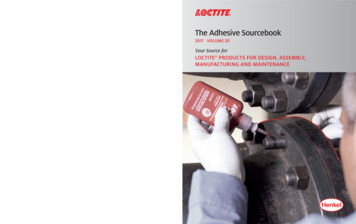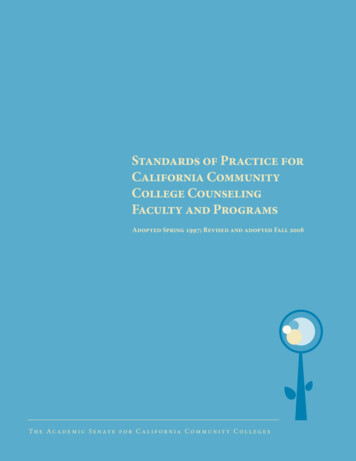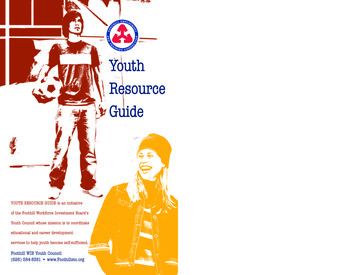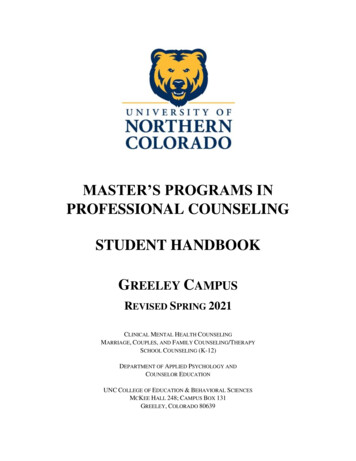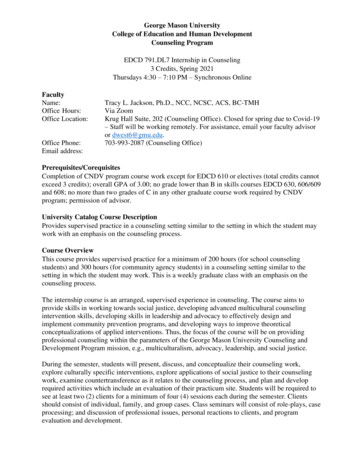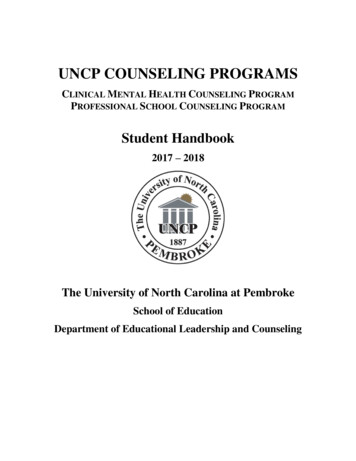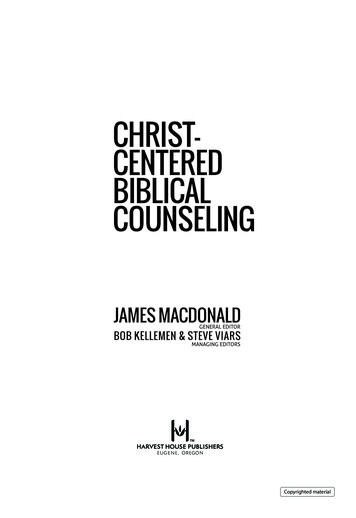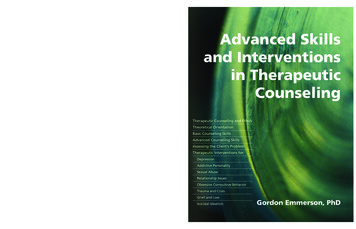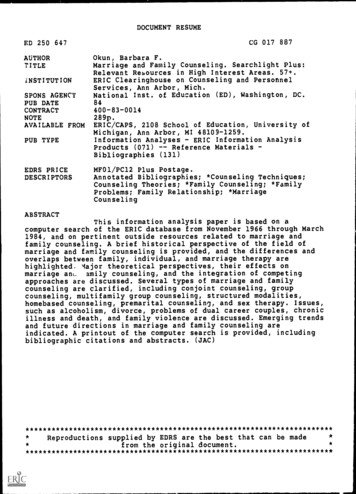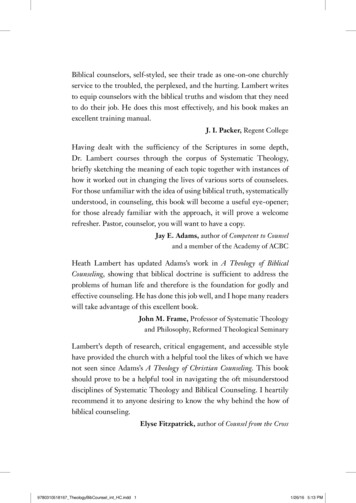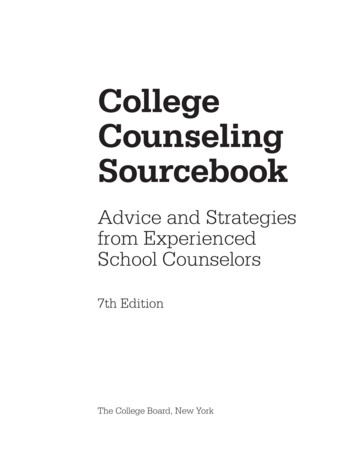
Transcription
CollegeCounselingSourcebookAdvice and Strategiesfrom ExperiencedSchool Counselors7th EditionThe College Board, New York
About the College BoardThe College Board is a mission-driven not-for-profit organization that connects students to college success andopportunity. Founded in 1900, the College Board was created to expand access to higher education. Today, themembership association is made up of over 6,000 of the world’s leading educational institutions and is dedicated topromoting excellence and equity in education. Each year, the College Board helps more than seven million studentsprepare for a successful transition to college through programs and services in college readiness and collegesuccess — including the SAT and the Advanced Placement Program . The organization also serves the educationcommunity through research and advocacy on behalf of students, educators and schools.For further information, visit www.collegeboard.org.Copies of this book may be ordered from College Board Publications, P.O. Box 4699, Mount Vernon, IL 62864. Thecost is 53.00; the item number is 110534614. A PDF of this book may be ordered online through the College BoardStore at store.collegeboard.org. The item number for the PDF version is 110534615. The price is 25.Material in handouts 10E and 10H is adapted from Advising Student Athletes Through the College RecruitmentProcess, 1996 by Michael D. Koehler. Reproduced by permission of Pearson Education, Inc. All rightsreserved. Pearson Education, Inc. For any further copying of this material, please contact Pearson Education,Inc., for permission.Library of Congress Control Number: 2004109694 2012 The College Board. College Board, Advanced Placement Program, AP, AP Central, CLEP, CollegeCredit,CollegeEd, College-Level Examination Program, CSS/Financial Aid PROFILE, SAT, SpringBoard, SSS, StudentSearch Service, and the acorn logo are registered trademarks of the College Board. AP Potential, College BoardStandards for College Success, MyRoad, SAT Preparation Booklet, SAT Preparation Center, SAT Reasoning Test,SAT Subject Tests, ScoreWrite, The Official SAT Online Course, The Official SAT Question of the Day, and TheOfficial SAT Study Guide are trademarks owned by the College Board. PSAT/NMSQT is a registered trademark ofthe College Board and National Merit Scholarship Corporation. ACT Assessment is a registered trademark of ACT,Inc. All other products or services may be trademarks of their respective owners. Visit the College Board on theWeb: www.collegeboard.org.Any handout in this book, unless otherwise noted, may be reproduced for educational purposes.
ContentsPreface and acknowledgments.xvEditorial advisory board. xviiHow to use this book.xixChapter 1: Fundamentals of college counselingOverview. 1-1The counselor’s role. 1-1Understanding your role. 1-2Competencies of the college admissions counselor . 1-3Job descriptions. 1-3Chart: Sample public school counselor job description.1-5Chart: Sample private school counselor job description.1-6Chart: Top 10 survival skills for school counselors. 1-7The Eight Components of College and Career Readiness Counseling.1-8Own the Turf. 1-11Month-by-month calendar of college counseling activities. 1-12How counselors use technology to communicate withstudents and parents. 1-18Resources. 1-20Professional organizations. 1-20The College Board. 1-20The National Association for College Admissions Counseling. 1-23The American School Counselor Association. 1-24Books. 1-25Websites. 1-26Chapter 2: Helping students prepare for collegeOverview. 2-1The counselor’s role.2-2Chart: Advocating for students.2-3High school courses and college-prep requirements.2-4Chart: Sample high school requirements and college requirements.2-5Community college requirements.2-6Student athletes and high school course work.2-6iii
Key research on the importance of high school course work. 2-7The Toolbox Revisited. 2-7The Bridge Project. 2-7The Education Trust.2-8College-level curriculum in high school.2-9Advanced Placement Program (AP ).2-9Chart: Sample AP policy at a large university. 2-12Community college courses . 2-13Chart: CLEP . 2-14Extracurriculars. 2-15Working with parents. 2-15The senior year. 2-17Resources. 2-18Websites. 2-18Publications. 2-19Chapter 3: Helping students research collegesOverview. 3-1The counselor’s role. 3-1How counselors can learn about colleges .3-2Visits from college representatives.3-3Strategies for learning what colleges are really like.3-5Organizing a college fair.3-6Organizing a presentation on college majors.3-8Creating newsletters and handbooks.3-9Advising students on “fit”. 3-11What Counselors Say About College Rankings. 3-13Working with parents. 3-14Explain admission factors. 3-14Creating a list of colleges. 3-15Resources. 3-16Websites. 3-16iv
Chapter 4: The college application processOverview.4-1The counselor’s role.4-1Different approaches to handling applications.4-2The application form.4-3Online applications.4-4The Common Application.4-4Other multi-use applications.4-5The transcript.4-5GPAs.4-5Transcripts and the law (FERPA). 4-6Transcripts for student athletes.4-7The school profile.4-7Format of a school profile.4-8Test scores.4-8Other components of the application.4-8Recommendations and essays .4-8Secondary school report form.4-9Midyear report.4-9Portfolio/audition.4-9Supplemental information. 4-10Early Decision (ED) and Early Action (EA). 4-10Technology tips. 4-12Resources. 4-12Books. 4-12Chapter 5: RecommendationsOverview.5-1The counselor’s role.5-1Counselor recommendations.5-2Teacher recommendations.5-2How counselors and teachers obtain the information they need.5-3How students request recommendations.5-4Students’ right to see the recommendations.5-4Advice from a college admissions dean on the counselorrecommendation.5-6Letters of recommendation: Advice from the Minnesota Office ofHigher Education.5-7v
Counselor and Teacher Letters of Recommendation: An ExperiencedPerspective by William C. Hiss.5-8Recommendations message board. 5-10Resources. 5-11Websites. 5-11Chapter 6: The application essayOverview.6-1The counselor’s role.6-1The essay: Purposes and types.6-1General and specific purposes.6-1Two types of essays.6-2Similarities and differences.6-3How many essays should a student write?.6-3How colleges use admission essays.6-4Who should help students with their essays?.6-5How counselors can help.6-5How teachers can help.6-6How parents can help.6-6Suggestions for helping seniors on the essay.6-7Resources for counselors.6-8Books.6-8Resources for students.6-8Books.6-8Chapter 7: College Board testsOverview. 7-1The counselor’s role. 7-2Preliminary SAT /National Merit ScholarshipQualifying Test (PSAT/NMSQT ).7-4When is the test given?.7-4When should students take the test?.7-4How is the test used by schools?.7-5How is the test used by colleges?.7-6Test format .7-6Scoring .7-8Preparation.7-8How schools share results with students and families.7-8Costs and fee waivers.7-9vi
Accommodations for students with disabilities.7-9Strategies for distributing PSAT/NMSQT scores. 7-10How the PSAT/NMSQT is used by the National Merit Scholarship Corporation. 7-11For more information . 7-11The SAT . 7-12Format and scoring. 7-12How colleges use the SAT. 7-13Who should take the test and when it is given. 7-13Practice. 7-13Registration, fees and fee waivers. 7-14Accommodations for students with disabilities. 7-15Score Reports. 7-16Free online information for SAT takers. 7-17Comparing SAT and ACT scores. 7-19Concordance study by ACT and the College Board. 7-19SAT Subject Tests . 7-19Format. 7-20How colleges use the SAT Subject Tests. 7-20When should students take the SAT Subject Tests?. 7-21Practice. 7-21Student Search Service : Connecting students to college. 7-22Resources. 7-23Publications. 7-23Websites. 7-23Chapter 8: Financial aidOverview.8-1The counselor’s role.8-2Terms to Know.8-3How financial aid helps families.8-7College costs: Adding it all up.8-7The College Board and financial aid.8-9Financial need: How it is determined.8-9What “expected family contribution” means. 8-10How Colleges Calculate Need. 8-11Independent students. 8-12The application process: Keeping an eye on the calendar. 8-12Deadlines and priority dates. 8-13The Two Main Forms. 8-14FAFSA. 8-14vii
A new tool to track FAFSA completion. 8-15CSS/Financial Aid PROFILE . 8-16Chart: The two main forms at a glance. 8-17Types of financial aid. 8-17How aid is awarded. 8-19What award letters look like.8-20Appealing an award.8-23Maintaining scholarship files and administering local scholarships.8-23ROTC.8-23Strategies for working with parents.8-24Students in foster care.8-25Chafee Educational Training Vouchers.8-25How to conduct financial aid events: One school’s approach .8-26Resources.8-28Websites.8-28Scholarship search engines.8-29Books.8-30Chapter 9: Counseling first-generation students about collegeOverview.
Copies of this book may be ordered from College Board Publications, P.O. Box 4699, Mount Vernon, IL 62864. The cost is 53.00; the item number is 110534614. A PDF of this book may be ordered online through the College Board Store at store.collegeboard.org. The item number for the
